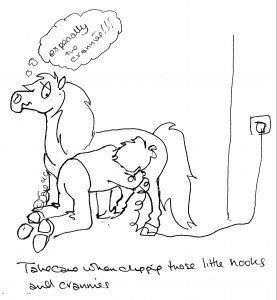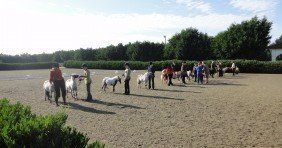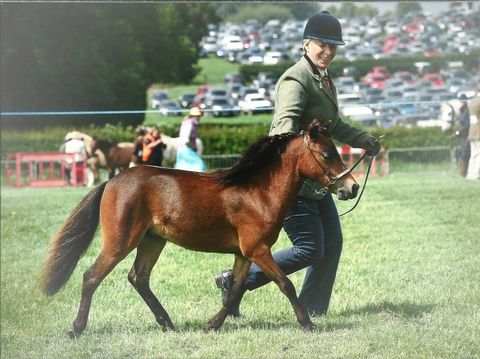Advice For Showing BMHS Horses
We hope everyone involved in the showing of BMHS horses will find the following page helpful. Complete Showing Rules can be found under the ‘Showing’ button.
What the Judge is Looking For
A British Miniature horse should be a miniature version of a quality ridden horse. Therefore, the same conformation traits and way of going are desirable. Horses must be well mannered at all times and should move well from the hindquarters.
There are various types of BMHS horses, some having more bone than others but they should all conform to the same skeletal structure as their full-sized counterparts. A guide to type is between a Hack and a Hunter in the height to weight ratio. They should never be ‘pony like’, i.e. small, wide head, short legs under a large body. Animals with plenty of bone should still be in proportion such that, when imagining the horse to be full sized, it should be an enjoyable ride, with the saddle fitting in the correct place and the horse able to work comfortably in a correct outline.
Good movement in a BMHS horse includes the hind legs properly engaged propelling the animal forward, not the front legs dragging it along. Front leg action is to some extent a matter of personal choice. Some people prefer a pointing toe ‘daisy cutting’ action whilst others choose a more upright front action.
Preparation
Feeding and Exercise
Proper feeding, nutrition and conditioning are all important for your miniature to reach its full potential and is not something that can be rushed into a few weeks before a show. Miniature horses have a tendency to become fat very easily so balancing feeding with exercise is essential. One of the very best methods of exercise is taking them for a walk, it satisfies their body and soul in one go. Gentle exercise this way builds correct muscle gradually and keeps the weight down (for both horse and handler!). Lunging and long-reining can also be helpful. Once your miniature is old enough, they will probably enjoy some jumping and pole work, also great for mental and physical fitness. This feed/weight balance is very specific to individual horses and can be tricky, so if you are not sure please contact the society office who will be very pleased to advise you. It is worth remembering that it is much easier to get weight off miniatures during winter as this time of year is the natural time for doing this.
Clipping and Trimming
Since the BMHS is a ‘horse’ society, we want to present miniatures in the show ring which look like tiny versions of full sized ridden horses. Therefore, they should be turned out neatly trimmed.
Techniques of trimming and clipping are quite an art and it takes some practise to really perfect it. The purpose of trimming and clipping is to enhance the good looks of your miniature. However, it should not in any way alter its natural conformation, colour or be detrimental to its well-being.

Here are some trimming methods which are acceptable for the show ring.
1. A bridle space may be cut at your discretion but must not be more than 10cms (4 inches long). This shows off the crest of the neck through to the jaw line.
2. The mane can be slightly thinned to give a light flowing effect. The shoulder must not be covered by a long mane.
3. Tails should be trimmed to enhance the hind quarters. A neat ‘pulled’ top can give the impression of well-rounded quarters whereby a thick top to the tail is more ‘pony looking,’ therefore to be avoided. The tail must be cut a minimum of 5cms from the ground or fetlock length.
4. Most miniature horses are clipped right out for showing. To get the best effect for the show ring plan to clip your horse 1 – 2 weeks before the show. This enables the coat to grow and settle flat. Leave yourself plenty of time – it is surprising how long it takes to clip out a tiny horse because of having to be so careful of the tiny nooks and crannies. If in doubt get an expert to do this job as it can be quite nerve wracking to begin with.
5. Final trimming of nose and chin whiskers (if you wish to trim these) can be left until nearer the show day. Horses are usually bathed before a show with specialist shampoos and conditioners. Always use warm water and dry them off quickly as, being so small, they catch cold very easily. Rug them warmly, including a neck cover, after bathing as they no longer have the natural oils in the coat to keep them warm.
6. On the day, just prior to entering the show ring, you may wish to add some final touches such as hoof oil, a touch of baby oil to a dark muzzle and dock, chalk block to white legs.

Showing Tack for your Miniature
Bridles with bits are not permissible for yearlings and two year olds but can be used on older horses if necessary. A simple snaffle bit is the preferred option.
Bear in mind the headgear you choose must be capable of controlling your horse whilst in the company of others. This photo shows two showing bridles with small chains. These can be quite severe as they act like a curb chain. On young animals it is very popular to use a less severe leather strap.
Choose your show bridle carefully. It should be elegant and show off the head to its best advantage. There are no rules about ‘bling’ on nosebands but often ‘less is more’. It is the owner/handler’s personal choice.

Dress Code for Handlers
WOMEN AND MEN
Hats – velvet covered riding hat / beagler, a flat cap or a bowler.
Clothes – Ankle length smart trousers (any colour). Straight, knee length, navy or black or tweed skirts maybe worn with flesh coloured or navy or black tights. Tweed/twill showing jacket, navy or black showing jacket or black suit. Shirt and tie or stock MUST be worn. Ankle boots or lace up shoes. Waistcoats maybe worn but must be under a jacket. Neutral coloured gloves.
CHILDREN (UNDER 14 YEARS)
Showing jacket, trousers/jodphurs, jodhpur boots or suitable leather shoes. Shirt and tie. Riding hat with appropriate safety harness to the BS quality. Neutral coloured gloves.
EVENING PERFORMANCE WEAR
MEN – black suit, white shirt, bow tie. Hat and/or gloves may be worn.
WOMEN– Black trousers, black or white top/jacket. Arms must be covered. Hat and/or gloves may be worn.
Normal showing attire may be worn.
Show Canes may be carried as an optional extra.
When choosing your showing outfit remember the colour of your clothes needs to allow the judge to easily see your
horse against you i.e. do not wear navy blue trousers if your horse has black legs as he will ‘disappear’ next to you. Choose wisely so your outfit enhances the overall picture of horse and handler.

Showing Conduct
From the moment you enter the ring you should keep an eye on the Judge and Steward at all times. For example, once all the exhibits have been walked around the arena simultaneously (usually on the right rein or clock-wise direction) you will be asked to wait in a queue whilst each horse is given the opportunity to show the judge its trot round the ring to the back of the queue. Whilst waiting your turn do not relax, be sure to keep your horse alert and obedient. At any time, the judge may glance your way to compare your horse with another. For safety reasons always maintain one horse’s length between exhibits.
Do NOT enter the show ring late without asking the judge (through the steward) for permission to do so. Likewise, if you need to leave the ring early for a genuine and unavoidable reason do not ask the judge directly but request through the steward.
Whilst it is acceptable to speak to the person standing next to you in the ring when the judge’s attention is elsewhere, make sure you keep attentive to the judge and steward as to ignore either of them is the height of bad manners.
You should do as the steward tells you at all times but if you do not understand, ask them, they are the salt of the earth, they stand around all day for no payment at all and they (usually) know what they are doing and are very kind.
When you present your horse to the judge for individual assessment, he or she will greet you with a ‘Good Morning’ or ‘Good Afternoon’, they may also ask you a question. Always respond briefly and politely but never start a conversation or volunteer information.

Attitude
We all win sometimes, although mostly we lose.
It is as important to be a good winner as it is to be a good loser. When you lose, and this often happens, the judge is not a) blind b) drunk c) short-sighted. They are choosing the horse they think is the best on the day, which is exactly what they have been asked to do.
It is extremely important that you never vent negative feelings about showing with the BMHS on social media. The BMHS has a Social Media Policy (in ‘Policies’ button on this website). Any negative writings on any social media platform can result in disciplinary proceedings.
Of course, the competitive edge comes out in all of us when we are showing our horses but it should be a pleasurable experience for both you and your horse – so have fun and be very proud of your special little horse where ever they are placed and remember, we all take the best horse home.

The BMHS Head Office, Stretcholt Farm, Bridgwater, TA6 4SR
| +44 (0)1278 685 943